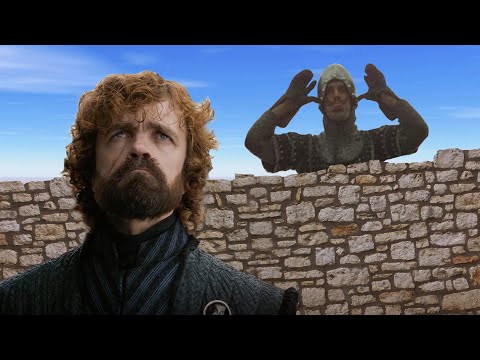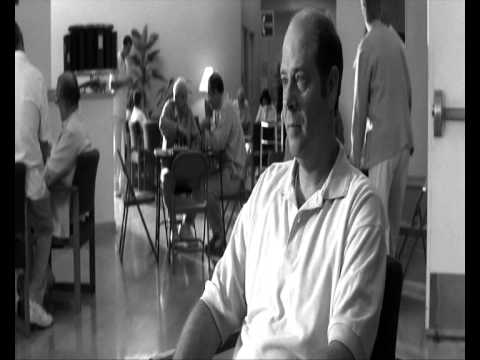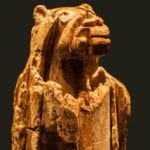10Monty Python Insults In Game Of Thrones
Like many of us, the creators of Game of Thrones are big Monty Python fans. At the very least, we know that series creator Dan Weiss and resident linguist David Peterson are. If you spoke fluent Low Valyrian, you might have noticed an exchange that sounded familiar. Watch this video on YouTube In a scene in season four of the show, Daenerys’s army reaches the gates of Meereen. A champion for the city rides out and begins taunting the Mother of Dragons before eventually getting dispatched. An interpreter translates the choice words the fighter has for Daenerys, but, according to the show’s linguist, he actually says lines like “Your mother was a hamster and your father smelled of elderberries.” Python fans will immediately recognize the lines as taunts from the Frenchman in Monty Python and the Holy Grail. David Peterson spent years working on the show’s three conlangs (“constructed languages”—whatever you do, don’t call them “made up”) using the info available from Martin’s books. They are Low Valyrian, High Valyrian, and Dothraki. The idea to include Python quotes came from Dan Weiss, and Anderson was eager to implement them. Although Dothraki is, by far, the favorite conlang of the show, fans were able to spot immediately in the scene that Missandei was holding out on us with her Low Valyrian translation.
9The Beatles And Rolling Stones Exchange Easter Eggs
Back in 1967, The Beatles released Sgt. Pepper’s Lonely Hearts Club Band, an iconic album that is still touted as one of the best of all time. Perhaps one of the most memorable aspects was the album cover, which featured a colorful and eclectic collection of famous characters from history along with various props. As a little nod to the musical rivalry they had with The Rolling Stones, the right side of the cover features a Shirley Temple doll wearing a “Welcome The Rolling Stones” T-shirt. A few months later, The Rolling Stones released their own album titled Their Satanic Majesties Request. While the album itself gained nowhere near the recognition of Sgt. Pepper’s, it did feature a colorful, psychedelic album cover that immediately drew comparisons to that of The Beatles. And that wasn’t coincidental. For starters, both covers were shot by the same photographer—Michael Cooper. While Cooper and the Stones realized the concepts of both album covers were similar, it was more about having the cover match the music. Even so, they planned to take it to another level by shooting the cover in 3-D lenticular. Eventually, the plan was scrapped when costs went over the budget, so the 3-D cover was only used for 500 limited edition albums, while everyone else got the standard 2-D version. However, this didn’t stop the Stones from sneaking in the heads of all Beatles members inside the flowers on the cover.
8The Devil Fresco
St. Francis of Assisi was an important figure for Christianity in Italy, mainly for establishing the Order of Friars Minor, which is more commonly known as the Franciscan Order. To celebrate him, a church was built in the 13th century in Assisi, the town where he lived and died. Over the centuries, the Basilica of St. Francis of Assisi turned into one of the most important Christian landmarks in Italy. It also became known as a place filled with beautiful frescoes done by some of the most talented Italian artists of the time like Cavallini and Cimabue. Another artist who contributed to the church was Giotto. He painted several frescoes and left us with a hidden message. The fresco in question depicts the death of St. Francis and his ascension to heaven. You have mourners, priests, saints and . . . the devil. Specifically, his face hidden in the clouds. We’ve only just discovered the face a few years ago. It remained hidden for almost 700 years because it is almost invisible from ground level and only becomes evident up close. We don’t really know why Giotto felt the need to incorporate the devil in the fresco. Some claim the depictions of demons in the sky were a common motif in Middle Age art as it was thought they impeded our ascension to heaven. If this is true, Giotto did it about 150 years earlier than the previous earliest known example. Others claim Giotto simply included the face of someone he didn’t like as revenge.
7The Eggs Of Satan Cookie Recipe
Everyone knows that if you want something to sound more menacing, you say it in German. American rock band Tool applied this concept to their 1996 album Aenima. The album has a track called “Die Eier Von Satan,” translated as “The Eggs of Satan.” It’s a heavy track featuring distortion and an industrial guitar backed by a cheering crowd that gets louder as the song progresses. All in all, it is reminiscent of a Nazi rally, and the “Satan” part in the title doesn’t help matters. However, those who speak German will understand the song for what it truly is—a cookie recipe. From start to finish, the song details a harmless recipe for making sugar cookies without using eggs. The only part that departs from a straight recipe is when it advises you to add a “knifetip of Turkish hash” to the mixture. This isn’t the first time the band had a little fun with their music. Their previous album, Undertow, had 58 silent one-second tracks so that a real hidden track, “Disgustipated,” would be number 69.
6Christopher Nolan’s Plot Twist Reveal
Movie Easter eggs are quite common as directors oftentimes like to include subtle jokes or references in their work. However, most of them aren’t clever enough to be worth mentioning. That’s not the case with Christopher Nolan’s Memento, a movie about a man with short-term amnesia looking for his wife’s killer. If you’ve never seen Memento, you might want to skip this entry because it’s going to spoil the big plot twist at the end. However, Christopher Nolan himself spoiled the ending halfway through the movie. If you didn’t catch the Easter egg, that’s because it’s only on the Limited Edition DVD. If you saw that version and still didn’t catch it, that’s because it’s only one quick frame. The movie tells the story of Leonard, a man with a weird form of amnesia that doesn’t allow him to form new memories. At the same time, Leonard speaks of Sammy, another man with the same kind of amnesia, who accidentally killed his wife. It’s revealed at the end that when he recounts part of Sammy’s story, Leonard is actually describing his own. One flashback scene shows Sammy in a mental asylum. Someone walks in front of the camera, and, when they move out of the way, Sammy turns into Leonard for a split second before the camera pans away. The movie is also unusual by showing its scenes in reverse order. As a bonus Easter egg, the DVD also allows you to see the movie in chronological order by unlocking a hidden feature in the menu.
5Caravaggio’s Decapitated Apology
Caravaggio liked to add personal touches to his works of art. Only recently were we able to use infrared technology and discover that the artist left a tiny self-portrait of himself as a young man hidden inside the wine carafe in his Bacchus painting. Caravaggio did a similar thing with one of his most famous paintings, David with the Head of Goliath. In this case, the Easter egg is far more obvious and didn’t require 21st-century technology to spot. The head of Goliath is actually the decapitated head of Caravaggio. In case you’re wondering why the artist portrayed himself like this, it was to apologize to the Pope. In 1606, Caravaggio had to flee Rome as he was wanted for murder. While in exile, he painted himself decapitated to suggest that he was a damned, repentant man. Caravaggio finished and sent the painting to the papal court in 1610 as a way of petitioning for a pardon. And his strategy worked, but Caravaggio never made it back to Rome as he died of fever in Porto Ercole.
4Aphex Twin’s Spectrogram
Richard David James, better known as Aphex Twin, is a successful British electronic musician. Arguably, his biggest hit came in 1999 when he released “Windowlicker” as a single. Later on it was released as an EP with two B-side tracks. One of them quickly caught people’s attention because it had the catchy name “ΔMi−1 = −αΣn=1NDi[n][Σj∈C[i]Fji[n − 1] +Fexti [n−1]].” Understandably, fans had a bit of difficulty pronouncing that, so the song became better known as “Equation.” However, the name would turn out to be the least bizarre aspect of the track. Listening to the song doesn’t tell you much. It’s when you put it under a spectrograph that things get weird. The spectrograph is capable of generating a spectrogram, which is a visual representation of sound waves. At first, everything looks normal, but watch the whole song through the spectrograph, and at the end, you get left with Aphex Twin’s hauntingly creepy face grinning at you. The artist embedded an image of his face into the sound. Turning words or an image into sound isn’t particularly difficult, given the proper software. It was turning the sound into a song that was the tricky part.
3Abstract Expressionist Icon In Regionalist Art
Thomas Hart Benton was an American painter who pioneered the Regionalist movement during the early 20th century. Along with other artists such as John Steuart Curry and Grant Wood, Benton moved away from the hustle and bustle of the big city and found inspiration in classic scenes of American rural life. Besides painting, Benton also had a prolific career as a teacher, inspiring a whole new wave of artists. Some of his prominent students included Glen Rounds, Margot Peet, Eric Bransby, Reginald Marsh, and even future actor Dennis Hopper. However, none of them compared to his most famous student, who would go on to pioneer his own artistic movement—Jackson Pollock. Pollock would go on to be a major figure in the abstract expressionistic movement that would topple regionalism art’s popularity. Even though he didn’t borrow much from his teacher’s subject matter, Pollock does make an appearance in one regionalist classic work of art. It’s a 1934 Thomas Benton painting called The Ballad of the Jealous Lover of Lone Green Valley. Based on a popular regional folk song, the painting shows a jealous man confronting his lover while a trio plays music in the foreground. And on the harmonica, we have a young Jackson Pollock who modeled for his teacher.
2National Lampoon/Marvel Crossover
Crossovers are quite common in comic books, but most of them are there for promotional purposes. However, one Iron Man issue did feature a quick cameo that most readers might have missed. The issue is Iron Man No. 217 from April 1986. The story is fairly straightforward—Tony Stark takes on longtime villain Justin Hammer and his creation, the Super-Adaptoid. They fight a bit, Iron Man triumphs, and everyone goes home happy. One notable aspect about this comic is that it marks the first appearance of Marcy Pearson, future PR Chief for Stark Enterprises and love interest for Rhodey. To impress her, Tony Stark takes Marcy on a trip to Disneyland, buying out the park so that the two of them can have some privacy. This annoys one particular family who have driven a long way just to see Disneyland and instead have to go to Wally World. The family in question is the Griswolds, the protagonists of National Lampoon’s Family Vacation movies.
1The Dark Side Of Washington National Cathedral
The Cathedral Church of Saint Peter and Saint Paul in the City and Diocese of Washington, better known as the Washington National Cathedral, is one of the largest cathedrals in the world and the second-largest in the United States. Even though construction started more than 100 years ago while Teddy Roosevelt was in office, it didn’t really finish until 1990, and minor decorative elements are still being added. Back in the ’80s, while the west towers were still under construction, the cathedral held a contest with the help of National Geographic. Kids were encouraged to send in drawings for decorative sculptures to be placed on the towers. Several winning designs were included in the construction, such as a raccoon and a girl with pigtails and braces, but the one that really stood out was the third-place winning submission—Darth Vader. Yes, the cathedral features one of the most iconic movie villains of all time. Vader was the entry of Christopher Rader from Kearney, Nebraska. The sculpture was created by Jay Hall Carpenter, who is responsible for hundreds of other carvings on the cathedral. Darth Vader still proudly overlooks the cathedral today, but viewers trying to catch a glimpse better bring a pair of binoculars, as he is difficult to spot. Radu is a history/science buff with an interest in all things bizarre and obscure. Share the knowledge on Twitter or check out his website.
























